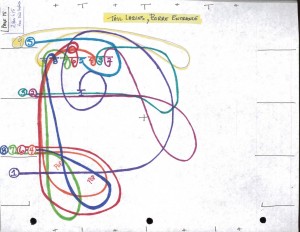Itchy wool, the smell of wet wool, trying to reshape a stretched out sweater – or worse, trying to stretch a shrunken one… When I think of dancing in a near floor-length dress made of wool these are the thoughts running through my mind.
In 1936 Martha Graham and her dancers were wearing costumes made of double knit wool. Thankfully, in 2014 Bryn Mawr and Haverford dancers will be wearing cotton jersey. Though it is still a somewhat heavy fabric to dance in (compared to the super-technology we now have in athletic gear) it is undoubtedly lighter than its 1930s counterpart – more of a second skin, less of a pelt.
Synthetics notwithstanding, these costumes are true to Graham’s 1930’s stipulations and to the nature of Steps in the Street – they are both determinedly solemn as well as deceptively complex. I would describe the costumes, at first glance, as: long black dresses – they are intended to just brush the top of the foot. The bodice is fitted, with cap sleeves and a square neckline – and with two princess seams running down its length, from where the neckline meets the sleeve (almost under the arm), over the bust, to a low dropped waist. Attached to this is a full skirt with overlapping material that forms a slit, which is not visible without movement.
These costumes are on loan as part of the reconstruction arrangement Bryn Mawr has with the Martha Graham Dance Company. The Graham Company suffered the great misfortune of losing many of their costumes, and sets and props, in a storage facility that was ruined during Hurricane Sandy. The costumes we are using this Spring are therefore reconstruction costumes that had to be reconstructed themselves post-Sandy and Bryn Mawr’s cast will only be the second to wear them.
A few weeks ago the dancers had their first rehearsal in costume. At that rehearsal I had an opportunity to speak briefly with Heidi Barr, who has done costuming for Bryn Mawr College’s Dance Concerts for a number of years. Heidi will be fitting and altering the costumes for our production of Steps in the Street.
Through our conversation Heidi brought into focus aspects of the costume that I, with my untrained eye, would not have immediately considered. Below, some examples are illustrated by photos of the dancers rehearsing in costume!


